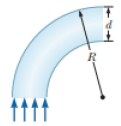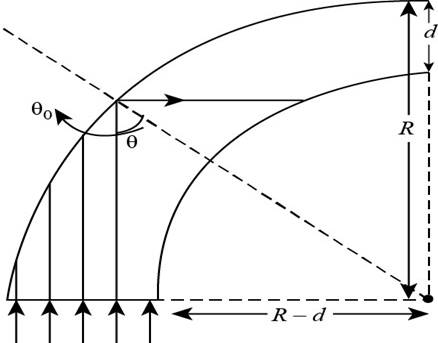
Concept explainers
An optical fiber has an index of refraction n and diameter d. It is surrounded by vacuum. Light is sent into the fiber along its axis as shown in Figure P34.31. (a) Find the smallest outside radius Rmin permitted for a bend in the fiber if no light is to escape. (b) What If? What result does part (a) predict as d approaches zero? Is this behavior reasonable? Explain. (c) As n increases? (d) As n approaches 1? (c) Evaluate Rmin assuming the fiber diameter is 100 μm and its index of refraction is 1.40.
Figure P34.31

(a)
Answer to Problem 35.49P
Explanation of Solution
Given info: The index of refraction is
The figure that represents the given conditions is shown below,

Figure (1)
From figure a ray originally moves along the inner edge will have the smallest angle of incidence when it strikes the outer edge of the fiber in the curve. Thus, if this ray is totally internally reflected, all of the others are also totally reflected.
The necessary condition for the ray to be total internal reflection is,
Here,
For very small value of
The above condition can be written as,
The expression of
Substitute 1 for the value of
The expression of
Here,
The expression of equation (1) becomes.
The minimum value of outside radius permitted for a bend in the fiber is
Conclusion:
Therefore, the smallest outside radius
(b)
Answer to Problem 35.49P
Explanation of Solution
The result from part (a) is,
Here,
The value of
The lesser value of
The thinner the optical fiber, the radius up to which the fiber is bent becomes smaller.
Conclusion:
Therefore, the
(c)
Answer to Problem 35.49P
Explanation of Solution
As
Here,
The above expression can be written as,
It is clear that as
Yes, as
Conclusion:
Therefore, the
(d)
Answer to Problem 35.49P
Explanation of Solution
As
Here,
The above expression can be written as,
It is clear that as
Yes, as
Conclusion:
Therefore, the value
(e)
Answer to Problem 35.49P
Explanation of Solution
Given info: The diameter of the fiber is
Explanation:
The formula to calculate the
Here,
Substitute
Conclusion:
Therefore, the value of
Want to see more full solutions like this?
Chapter 35 Solutions
Physics for Scientists and Engineers, Technology Update (No access codes included)
- How many times will the incident beam in Figure P34.33 (page 922) be reflected by each of the parallel mirrors? Figure P34.33arrow_forwardFigure P23.28 shows a curved surface separating a material with index of refraction n1 from a material with index n2. The surface forms an image I of object O. The ray shown in red passes through the surface along a radial line. Its angles of incidence and refraction are both zero, so its direction does not change at the surface. For the ray shown in blue, the direction changes according to n1 sin 1 = n2 sin 2. For paraxial rays, we assume 1 and 2 are small, so we may write n1 tan 1 n2 tan 2. The magnification is defined as M = h/h. Prove that the magnification is given by M = n1q/n2p. Figure P23.28arrow_forwardA ray of light strikes a flat, 2.00-cm-thick block of glass (n = 1.50) at ail angle of 30.0 with respect to the normal (Fig. P22.18). (a) Find the angle of refraction at the lop surface. (b) Find the angle of incidence at the bottom surface and the refracted angle. (c) Find the lateral distance d by which the light beam is shifted. (d) Calculate the speed of light in the glass and (e) the time required for the light to pass through the glass block. (f) Is the travel time through the block affected by the angle of incidence? Explain.arrow_forward
- An optical fiber has an index of refraction n and diameter d. It is surrounded by vacuum. Light is sent into the fiber along its axis as shown in Figure P34.31. (a) Find the smallest outside radius Rmin permitted for a bend in the fiber if no light is to escape. (b) What If? What result does part (a) predict as d approaches zero? Is this behavior reasonable? Explain. (c) As n increases? (d) As n approaches 1? (c) Evaluate Rmin assuming the fiber diameter is 100 m and its index of refraction is 1.40. Figure P34.31arrow_forwardFigure P26.72 shows a thin converging lens for which the radii of curvature of its surfaces have magnitudes of 9.00 cm and 11.0 cm. The lens is in front of a concave spherical mirror with the radius of curvature R = 8.00 cm. Assume the focal points F1 and F2 of the lens are 5.00 cm from the center of the lens. (a) Determine the index of refraction of the lens material. The lens and mirror are 20.0 cm apart, and an object is placed 8.00 cm to the left of the lens. Determine (b) the position of the final image and (c) its magnification as seen by the eye in the figure. (d) Is the final image inverted or upright? Explain.arrow_forwardFigure P23.28 shows a curved surface separating a material with index of refraction n1 from a material with index n2. The surface forms an image I of object O. The ray shown in red passes through the surface along a radial line. Its angles of incidence and refraction are both zero, so its direction does not change at the surface. For the ray shown in blue, the direction changes according to n1 sin 1 = n2 sin 2. For paraxial rays, we assume 1 and 2 are small, so we may write n1 tan 1 n2 tan 2. The magnification is defined as M = h/h. Prove that the magnification is given by M = n1q/n2p. Figure P23.28arrow_forward
 Physics for Scientists and Engineers with Modern ...PhysicsISBN:9781337553292Author:Raymond A. Serway, John W. JewettPublisher:Cengage Learning
Physics for Scientists and Engineers with Modern ...PhysicsISBN:9781337553292Author:Raymond A. Serway, John W. JewettPublisher:Cengage Learning Physics for Scientists and EngineersPhysicsISBN:9781337553278Author:Raymond A. Serway, John W. JewettPublisher:Cengage Learning
Physics for Scientists and EngineersPhysicsISBN:9781337553278Author:Raymond A. Serway, John W. JewettPublisher:Cengage Learning Principles of Physics: A Calculus-Based TextPhysicsISBN:9781133104261Author:Raymond A. Serway, John W. JewettPublisher:Cengage Learning
Principles of Physics: A Calculus-Based TextPhysicsISBN:9781133104261Author:Raymond A. Serway, John W. JewettPublisher:Cengage Learning Physics for Scientists and Engineers: Foundations...PhysicsISBN:9781133939146Author:Katz, Debora M.Publisher:Cengage Learning
Physics for Scientists and Engineers: Foundations...PhysicsISBN:9781133939146Author:Katz, Debora M.Publisher:Cengage Learning Physics for Scientists and Engineers, Technology ...PhysicsISBN:9781305116399Author:Raymond A. Serway, John W. JewettPublisher:Cengage Learning
Physics for Scientists and Engineers, Technology ...PhysicsISBN:9781305116399Author:Raymond A. Serway, John W. JewettPublisher:Cengage Learning College PhysicsPhysicsISBN:9781305952300Author:Raymond A. Serway, Chris VuillePublisher:Cengage Learning
College PhysicsPhysicsISBN:9781305952300Author:Raymond A. Serway, Chris VuillePublisher:Cengage Learning





